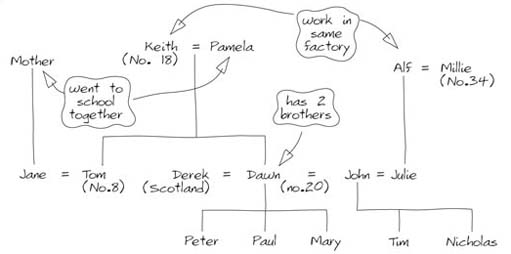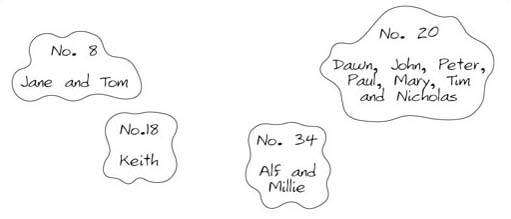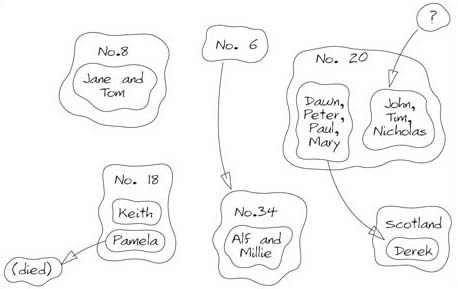3.5 Working with other people's diagrams – representing text as diagrams
In this section I want to show how you can use diagrams to help you understand what someone else has written, and it does not matter how well you can draw as long as they make sense to you. As you become more confident at drawing diagrams for yourself, you will then be able to move on to drawing diagrams to show someone else.
At this stage you might still be doubtful as to the usefulness of diagrams for understanding situations. So, why not try using one?
Box 1
Jane is married to Tom and they live at No. 8. Tom's sister Dawn lives at No. 20 and has three children, Peter, Paul and Mary. Her partner Derek left her 4 years ago and moved to Scotland, but now she is living with John. John has two children of his own, Tim and Nicholas, from his marriage to Julie. Julie's father, Alf, works in the same factory as Tom's father, while Dawn and Jane's mother went to school together. Alf and Millie live at No. 34. They used to live at No. 6, but moved after the children left home. Dawn has two older brothers, one of whom has moved away. Keith and Pamela are Tom's parents, but Pamela died last year. Keith now lives alone at No. 18.
Activity 2
Quickly sketch one or two diagrams to more clearly convey the relationships described in Box 1. It is a good idea to start with a large blank piece of paper so that your diagram won't be cramped.
Discussion
The situation described in the box is messy and complicated to follow as text. When I gave this activity to several students some produced diagrams like that shown in Figure 4. This does begin to make the situation more understandable, but is still a bit messy. However, other students eventually realised that they needed two diagrams. The first one (Figure 5) shows who is related to whom as just two family trees while the second (Figure 6) shows who lives in which house. I certainly found that looking at these two diagrams made things a lot clearer for me, in particular the relationships between two different sets of connected things. Of course, these are the ways some chose to represent the situation and the diagrams do not include all the information given in the box – they selected what they thought was essential. Someone who read an early draft of this section suggested that I could mark on Figure 6 the arrivals and departures as well (see Figure 7) as some tried to do in Figure 4, while a few students actually drew Figure 6 as a line of boxes rather than blobs to show that the street is likely to be a ‘line’ of houses. You could have used different ways of analysing this text, such as spray diagrams, but whatever the type of diagram I am sure that the process of producing the diagram improved your understanding of the situation. Whether you think your diagram would clearly convey the situation to other people can only be tested by trying it out and indeed the comments of others can be very helpful, as seen above.




I hope this example has shown you some of the value of using diagrams rather than text to represent some relationships. Diagrams allow the relationships between parts of a situation to be seen at the same time as the parts themselves. And, whether or not your diagram makes sense to other people, it can help you to understand. When you can see the whole situation sketched out in front of you, then you are in a position to check (or ask someone else to check) whether all the links you have shown are logical, and whether you have included all the essential components. If the diagram does not make sense to you, then it may be that you have failed to understand the text. But if your diagram does make sense then there is an additional bonus – it is often much easier to remember information in diagram form than as strings of information. Which would you find easier to remember – the text in Box 1 or the diagrams the students produced?
